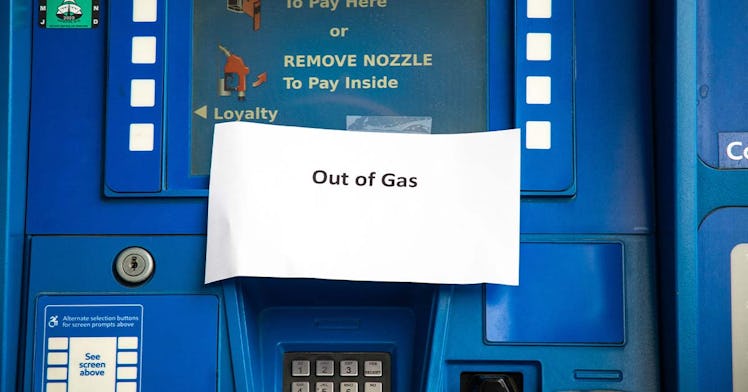There’s A Gasoline Shortage. Here’s How to Know if You’ll Be Affected
Here's what you need to know.

By now, you may have heard some rumblings about a gas shortage, and panicked stories of people turning up to gas stations where no gasoline is to be found. (You may have even seen the United States Product Safety Commission asking folks not to put gasoline in plastic bags.)
And after noticing your tank is uncomfortably close to empty, you may be wondering if you need to stock up on gasoline before society crumbles into a Mad Max hellscape.
Well, you needn’t worry. But if you’re trying to figure out what the hell is going on with the gasoline shortage, where it’s happening, why it’s happening, and if you should stock up on gas, here’s what to know.
There’s a gas shortage? Is it everywhere?
Yes, there is a temporary gasoline shortage, but it’s regional (so far).
Here’s the deal: a cyberattack on the Colonial Pipeline, which brings jet fuel and gasoline to the Eastern seaboard, has brought down operations of the pipeline and has lead to temporary gasoline shortages.
And it’s true that over 1,000 gas stations in the United States have run out of gasoline. But for now, it’s pretty much exclusive to the east coast and southeast. North Carolina has been the state most affected, as nearly 28 percent of stations have run out of gas.
Virginia and Georgia have had nearly 17 percent of stations run out of gas as well, and some localities have it worse — according to USA Today, 59 percent of metro Atlanta’s gas stations were out of gas. West Virginia and Kentucky are also experiencing some gasoline shortages, and Alabama, Tennessee, Florida, Maryland, and South Carolina are also feeling a pinch, per Patrick de Haan, an oil expert.
I don’t live in any of these areas. Will I be affected?
These shortages could expand, but pipeline officials expect that the service to be restored by the end of the week, meaning that gas will flow soon enough.
There are signs that other states could be affected — the Philadelphia region, for example, may soon be hit by the shortages — but it should be over soon.
In the meantime, check out Gasbuddy.com, which has a tracker which shows what gas stations have fuel, power, limited fuel options, etc., across the country, for real time information about your gas options.
How did the gasoline shortage start?
A cyber hack of the Colonial Pipeline, which delivers about 45 percent of the fuel used along the Eastern Seaboard, resulted in all operations being halted over the weekend.
The cyberattack, per NPR, disabled the computer systems that are responsible for fuel production in large swathes of the country, but pipeline operations should return to normal by the end of the week, meaning this is just a temporary — if deeply annoying — blip.
The public began to take notice when drivers found empty gas pumps and shortly after, some people began attempting to hoard gas in fear of a long-term shortage.
This obviously sparked more panic, as people were surprised to find massive lines at the gas station, which is almost always the sign of something more ominous, so people began to hoard gasoline.
Are things going to get worse?
The Biden administration says that this shortage is only temporary, so the supply issue isn’t one that is going to linger.
Federal agencies focusing their attention on solving the issue that they can — getting gasoline to the hardest hit areas — by methods potentially other than pipeline, so that people can go back to work, and so that prices don’t increase further.
Until that happens, the government is urging people to not hoard gasoline. But until the Colonial Pipeline is back at full capacity, much of the east coast could find themselves running short on gasoline.
What does this mean for gas prices?
That mostly depends on where you live. While the average price of gas has risen to above $3 as a result of increased demand and lack of supply, prices will obviously go up more dramatically in areas where there is a shortage of gas.
So if you live on the east coast or southeast, you may see prices spike but for now, other parts of the country should only see minor price changes (not to mention the fact that gas prices were already increasing anyway.)